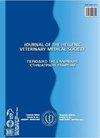生牛奶中耐甲氧西林金黄色葡萄球菌的存在:粘附能力和细胞外酶特性
IF 0.4
4区 农林科学
Q4 VETERINARY SCIENCES
引用次数: 0
摘要
耐甲氧西林金黄色葡萄球菌(MRSA)污染原料奶威胁食品安全并导致公共卫生问题。本研究对生牛奶中21种MRSA的生物膜形成及毒力因子进行了评价。采用全自动VITEK2系统筛选头孢西林,确定耐甲氧西林,最小抑菌浓度大于8mg /l。在刚果红琼脂(CRA)上对产膜菌株进行定性鉴定,并在96孔组织培养板(TCP)上进行半定量粘附试验。评估了产生不同酶的能力,如酪蛋白酶、脂肪酶和磷脂酶(卵磷脂酶)。测定细菌的表面疏水性,利用自聚集试验预测细菌细胞间的相互作用。61.9%的菌株在CRA中产生生物膜,呈现阳性和可变表型。此外,19.05%和80.95%的菌株在TCP上形成高、低生物膜。酶活性测定结果表明,在100%、80.95%和80.95%的病例中检测到l - cithinase、casease和脂肪酶的活性。MRSA分离株具有高度亲水性(85.71%)和弱疏水性(14.29%)。71.43%的菌株为中度自聚集,28.57%的菌株为低自聚集。CRA方法与TCP (P>0.05)。金黄色葡萄球菌菌株的粘附能力与细菌自身聚集之间存在显著关联(p>0.05)。另一方面,微生物菌株的疏水性与粘附能力之间没有统计学相关性(p<0.05)。微生物菌株的疏水性和自聚集性结果相同(p<0.05)。本研究可为葡萄球菌耐药制定新的控制措施、预防和有效治疗提供参考。本文章由计算机程序翻译,如有差异,请以英文原文为准。
Presence of methicillin-resistant Staphylococcus aureus in raw cow’s milk: adhesive capacities and extracellular enzymes characterization
Raw milk contamination by Methicillin-resistant S. aureus (MRSA) threatens food safety and leads to public health problems. Our study evaluates biofilm formation and virulence factors among 21 MRSA in raw cow’s milk. Methicillin resistance was confirmed by cefoxitin screening using the automated VITEK2 system, with a minimum inhibitory concentration greater than 8 mg/l. Qualitative characterization of biofilm-producing strains was performed on Congo red agar (CRA), with a semi-quantitative adhesion test on 96-well tissue culture plates (TCP). The ability to produce different enzymes was evaluated, such as caseinase, lipase, and phospholipase (lecithinase). The surface hydrophobicity of the bacteria was determined, and the autoaggregation test was used to predict the interactions between bacterial cells. Among the tested strains, 61.9% were biofilm producers in the CRA, developing a positive and variable phenotype. Furthermore, 19.05% and 80.95% of isolates were high and low biofilm formation on TCP. The enzymatic activity showed that lécithinase, caseinase, and lipase activities were detected in 100%, 80.95%, and 80.95% of cases. Highly hydrophilic (85.71%) and weakly hydrophobic (14.29%) were detected in MRSA isolates. The strains showed that 71.43% were moderate autoaggregation and 28.57% were low autoaggregation. No significant difference was found between the CRA method and TCP (P> 0.05). A significant association was found between adhesion capacity and bacterial autoaggregation in S. aureus strains (p>0.05). On the other hand, no statistical association between the hydrophobicity of microbial strains and adhesion capacity (p<0.05) was found. The same result was for the hydrophobicity of microbial strains and autoaggregation (p<0.05). This investigation could be beneficial for developing new control measures, prevention, and effective treatment against staphylococcal bacterial resistance.
求助全文
通过发布文献求助,成功后即可免费获取论文全文。
去求助
来源期刊

Journal of the Hellenic Veterinary Medical Society
VETERINARY SCIENCES-
CiteScore
0.60
自引率
0.00%
发文量
83
审稿时长
>12 weeks
期刊介绍:
The Journal of the Hellenic Veterinary Medical Society (J Hellenic Vet Med Soc) is a quarterly peer-reviewed journal that publishes articles in all aspects of veterinary science and related disciplines. It is published by the Hellenic Veterinary Medical Society and is indexed in the Web of Science and in Scopus.
There are no publication fees in the journal. Authors considering submitting manuscripts for evaluation and publication are requested to read carefully the instructions for authors and fully comply with them.
Non-complying manuscripts may be returned to the corresponding author for formatting.
 求助内容:
求助内容: 应助结果提醒方式:
应助结果提醒方式:


